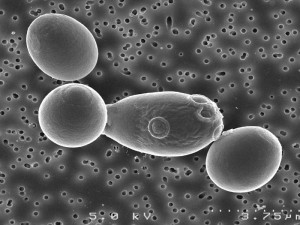 About Saccharomyces boulardii
About Saccharomyces boulardii
S. boulardii is a tropical strain of yeast first isolated from lychee and mangosteen fruit in 1923 by French scientist Henri Boulard.
Boulard first isolated the yeast after he observed natives of Southeast Asia chewing on the skin of lychee and mangosteen in an attempt to control the symptoms of cholera. S. boulardii has been shown to be non-pathogenic, non-systemic (it remains in the gastrointestinal tract rather than spreading elsewhere in the body), and grows at the unusually high temperature of 37°C.
Possible Benefits
There are numerous randomized, double-blind placebo-controlled studies showing the efficacy of S. boulardii in the treatment and prevention of gastrointestinal disorders. [1]
Acute diarrhea
Two studies each showed a significant reduction in the symptoms of acute gastroenteritis in children, versus placebo, by measuring frequency of bowel movements and other criteria. Children over three months are recommended to take two doses of 250 mg a day (BID) for five days to treat acute diarrhea. [2, 3] Children under three months are recommended to take half a 250 mg capsule or sachet twice daily for five days.
A prospective placebo-controlled study found a significant reduction in symptoms of diarrhea in adults as well taking 250 mg of S. boulardii twice a day for five days or until symptoms are relieved. [4]
Recurrent Clostridium difficile infection
Administration of two 500 mg doses per day of S. boulardii when given with one of two antibiotics (vancomycin or metronidazole) was found to significantly reduce the rate of recurrent Clostridium difficile (pseudomembranous colitis) infection. No significant benefit was found for prevention of an initial episode of Clostridium difficile-associated disease. [5]
Irritable bowel syndrome
A prospective placebo-controlled study found patients with diarrhea predominant irritable bowel syndrome (IBS) had a significant reduction on the number and consistency of bowel movements. [6]
Inflammatory bowel disease
Further benefits to inflammatory bowel disease (IBD) patients have been suggested in the prevention of relapse in Crohn’s disease patients currently in remission [7] and benefits to ulcerative colitis patients currently presenting with moderate symptoms. The recommended dosage is three 250 mg capsules a day (TID). [8]
Travelers’ diarrhea
Austrian vacationers taking S. boulardii traveling around the world were found to have significantly fewer occurrences of travelers’ diarrhea than those taking placebo. The more S. boulardii taken in prevention, starting five days before leaving, the higher the reduction in diarrhea reported. The reduction was also found to be dependent upon where the vacationer traveled. [9] The recommended dosage is one 250 mg capsule or sachet per day (QD).
Antibiotic-associated diarrhea
There is evidence for its use in the prophylactic (preventative) treatment of antibiotic-associated diarrhea (AAD) in adults. [10] There is further evidence for its use to prevent AAD in children. [11]
HIV/AIDS-associated diarrhea
S. boulardii has been shown to significantly increase the recovery rate of stage IV AIDS patients suffering from diarrhea versus placebo. On average, patients receiving S. boulardii gained weight while the placebo group lost weight over the 18 month trial. [12] There were no reported adverse reaction observed in these immunocompromised patients.
Sources:
- Vandenplas Y (July 1999). “Bacteria and yeasts in the treatment of acute and chronic infectious diarrhea. Part II: Yeasts”. Clin. Microbiol. Infect. 5 (7): 389–395. doi:10.1111/j.1469-0691.1999.tb00162.x. PMID 11853563.
- Centina-Sauri G, Sierra Basto G (1994). “Therapeutic evaluation of Saccharomyces boulardii in children with acute diarrhea”. Ann Pediatr 41: 397–400.
- Kurugöl Z, Koturoğlu G (2005). “Effects of Saccharomyces boulardii in children with acute diarrhoea”. Acta Paediatr. 94 (1): 44–7. doi:10.1080/08035250410022521. PMID 15858959.
- Höchter W, Chase D, Hagenhoff G (1990). “Saccharomyces boulardii in acute adult diarrhoea. Efficacy and tolerance of treatment”. Münch Med Wochenschr 132: 188–92.
- McFarland L, Surawicz C, Greenberg R (1994). “A randomised placebo-controlled trial of Saccharomyces boulardii in combination with standard antibiotics for Clostridium difficile disease”. J Am Med Assoc 271 (24): 1913–8. doi:10.1001/jama.271.24.1913. PMID 8201735.
- Maupas J, Champemont P, Delforge M (1983). “Treatment of irritable bowel syndrome with Saccharomyces boulardii: a double blind, placebo controlled study”. Medicine Chirurgie Digestives 12 (1): 77–9.
- Guslandi M, Mezzi G, Sorghi M, Testoni PA (2000). “Saccharomyces boulardii in maintenance treatment of Crohn’s disease”. Dig. Dis. Sci. 45 (7): 1462–4. doi:10.1023/A:1005588911207. PMID 10961730.
- Guslandi M, Giollo P, Testoni PA (2003). “A pilot trial of Saccharomyces boulardii in ulcerative colitis”. Eur J Gastroenterol Hepatol 15 (6): 697–8. doi:10.1097/01.meg.0000059138.68845.06 (inactive 2010-03-18). PMID 12840682.
- Kollaritsch H, Kemsner P, Wiedermann G, Scheiner O (1989). “Prevention of traveler’s diarrhoea. Comparison of different non-antibiotic preparations”. Travel Med Int: 9–17.
- McFarland LV, Surawicz CM, Greenberg RN, et al. (1995). “Prevention of beta-lactam-associated diarrhea by Saccharomyces boulardii compared with placebo”. Am. J. Gastroenterol. 90 (3): 439–48. PMID 7872284.
- Kotowska M, Albrecht P, Szajewska H (2005). “Saccharomyces boulardii in the prevention of antibiotic-associated diarrhoea in children: a randomized double-blind placebo-controlled trial”. Aliment. Pharmacol. Ther. 21 (5): 583–90. doi:10.1111/j.1365-2036.2005.02356.x. PMID 15740542.
- Saint-Marc T, Blehaut H, Musial C, Touraine J (1995). “AIDS related diarrhea: a double-blind trial of Saccharomyces boulardii“. Sem Hôsp Paris 71: 735–41.


Leave a Reply
Privacy Policy: ProbioticsDB.com only uses your information to respond to any questions you may have. We will not contact you for any other purposes and will not sell, distribute, or disseminate your information.